Project Management Report: Case Scenario 2 Analysis, University Study
VerifiedAdded on 2022/08/16
|26
|3777
|17
Report
AI Summary
This report, directed to a project sponsor, delves into the critical role of structured communication and the selection of appropriate methodologies in project management, using a case scenario involving a trip to Uganda. The report emphasizes the need for effective communication between project managers and team members, highlighting its impact on risk mitigation, knowledge transfer, and overall project success. It then evaluates three key project management methodologies: Agile, Waterfall, and PRINCE2, comparing their features, advantages, and disadvantages. The analysis concludes that the Waterfall methodology is best suited for the Uganda trip project due to its predetermined schedule and fixed budget. The report also includes a Project Initiation Document (PID), Work Breakdown Structure (WBS), and stakeholder analysis, providing a comprehensive overview of project planning and execution, with a focus on achieving the project objectives within budget and timescale.
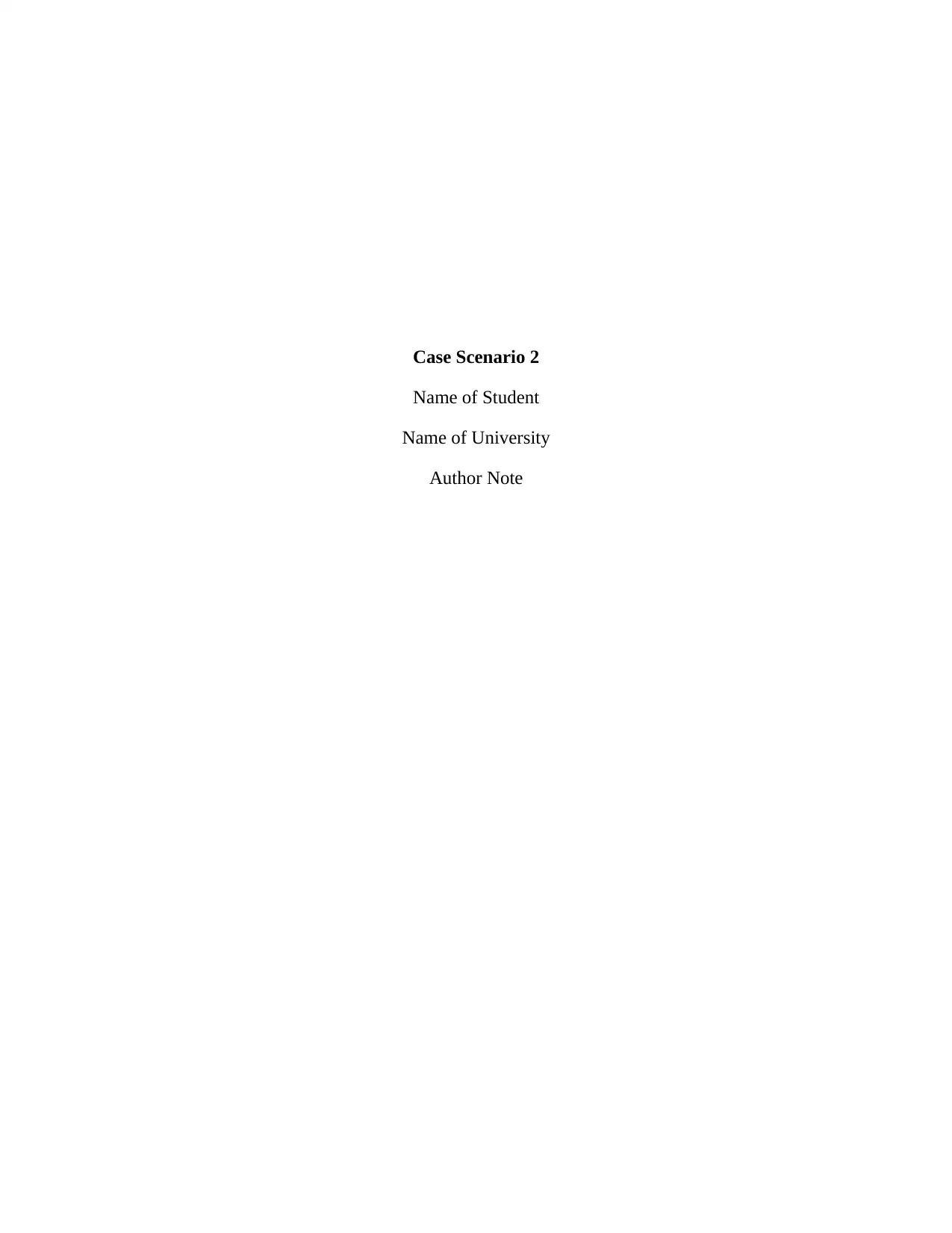
Case Scenario 2
Name of Student
Name of University
Author Note
Name of Student
Name of University
Author Note
Paraphrase This Document
Need a fresh take? Get an instant paraphrase of this document with our AI Paraphraser
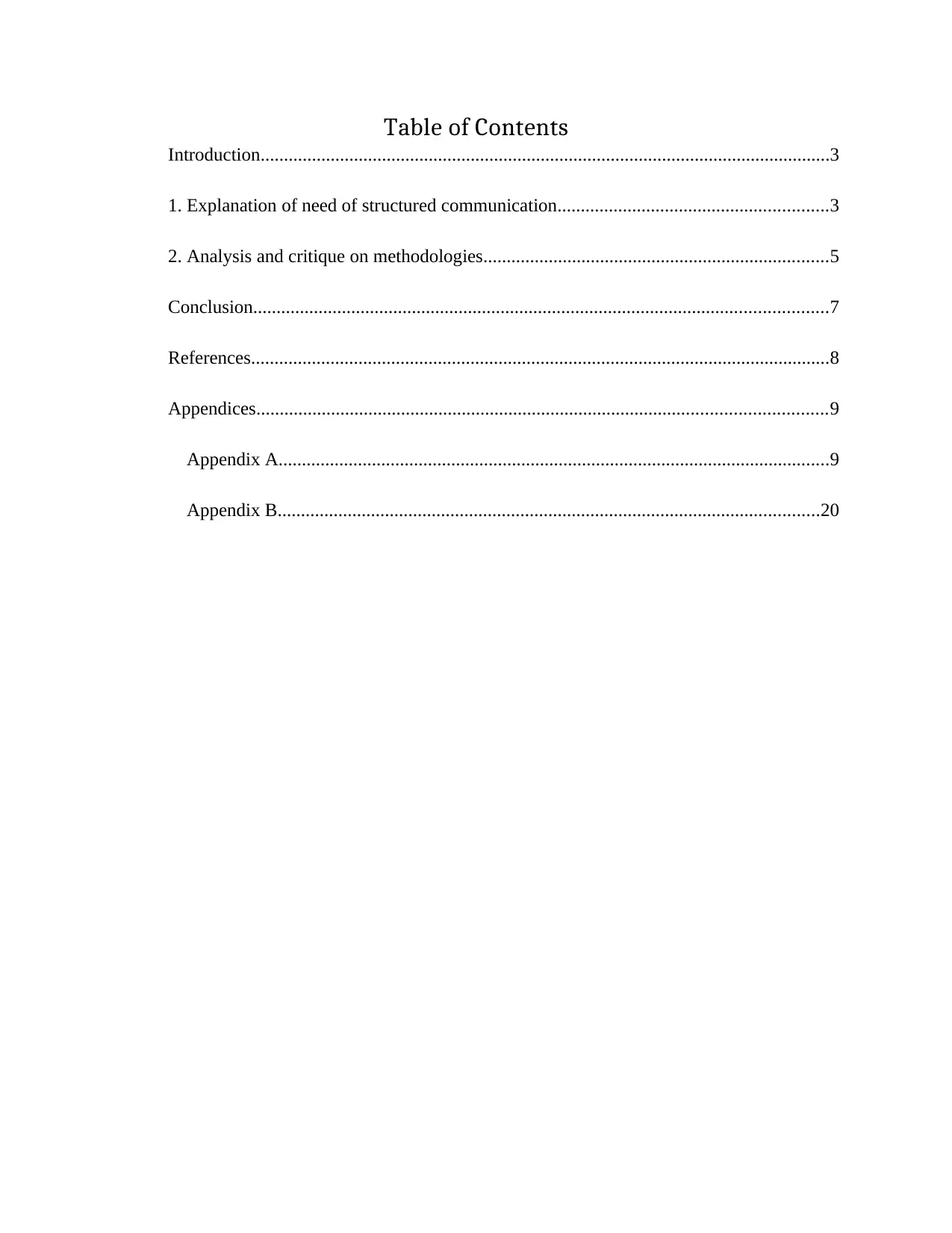
Table of Contents
Introduction..........................................................................................................................3
1. Explanation of need of structured communication..........................................................3
2. Analysis and critique on methodologies..........................................................................5
Conclusion...........................................................................................................................7
References............................................................................................................................8
Appendices..........................................................................................................................9
Appendix A......................................................................................................................9
Appendix B....................................................................................................................20
Introduction..........................................................................................................................3
1. Explanation of need of structured communication..........................................................3
2. Analysis and critique on methodologies..........................................................................5
Conclusion...........................................................................................................................7
References............................................................................................................................8
Appendices..........................................................................................................................9
Appendix A......................................................................................................................9
Appendix B....................................................................................................................20
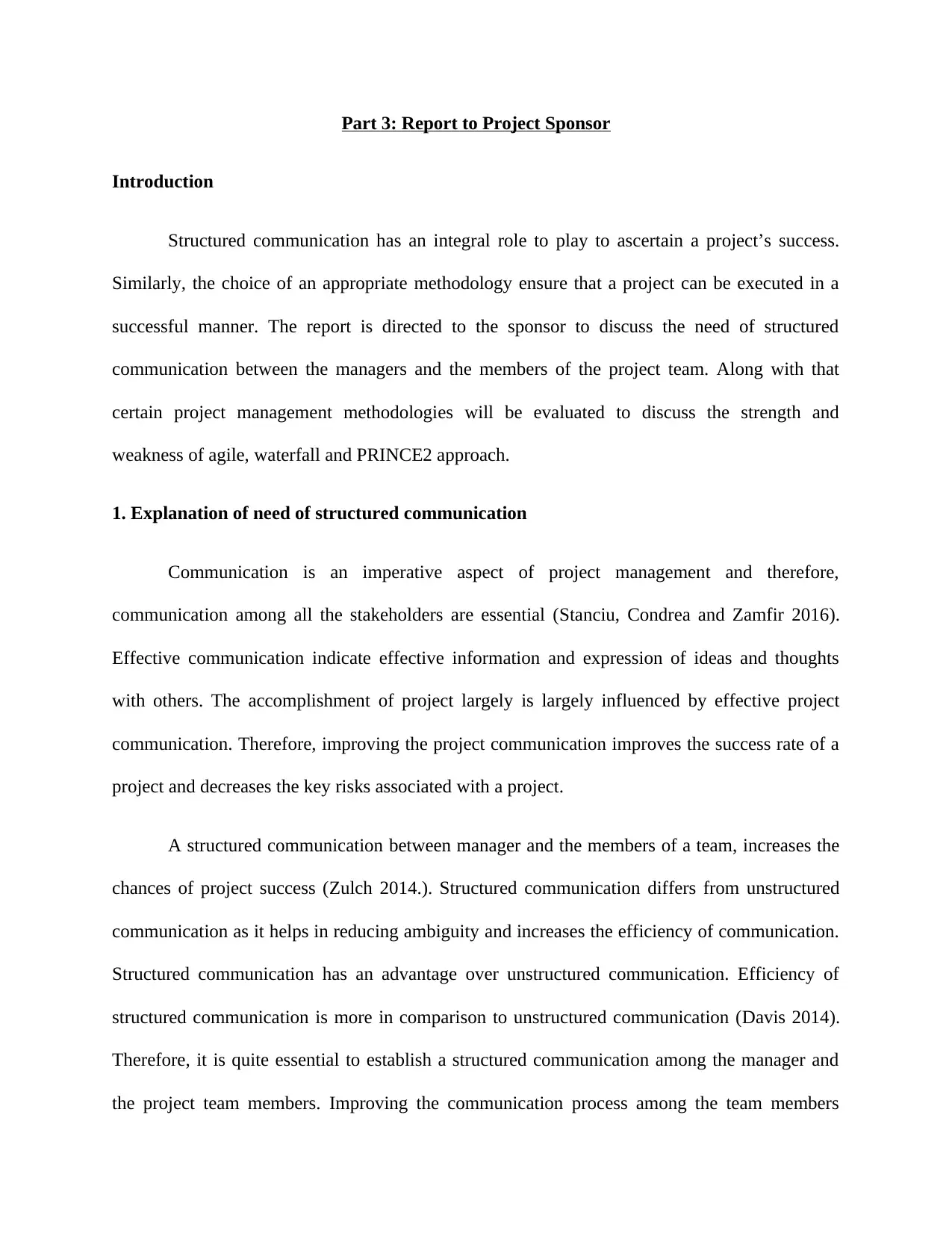
Part 3: Report to Project Sponsor
Introduction
Structured communication has an integral role to play to ascertain a project’s success.
Similarly, the choice of an appropriate methodology ensure that a project can be executed in a
successful manner. The report is directed to the sponsor to discuss the need of structured
communication between the managers and the members of the project team. Along with that
certain project management methodologies will be evaluated to discuss the strength and
weakness of agile, waterfall and PRINCE2 approach.
1. Explanation of need of structured communication
Communication is an imperative aspect of project management and therefore,
communication among all the stakeholders are essential (Stanciu, Condrea and Zamfir 2016).
Effective communication indicate effective information and expression of ideas and thoughts
with others. The accomplishment of project largely is largely influenced by effective project
communication. Therefore, improving the project communication improves the success rate of a
project and decreases the key risks associated with a project.
A structured communication between manager and the members of a team, increases the
chances of project success (Zulch 2014.). Structured communication differs from unstructured
communication as it helps in reducing ambiguity and increases the efficiency of communication.
Structured communication has an advantage over unstructured communication. Efficiency of
structured communication is more in comparison to unstructured communication (Davis 2014).
Therefore, it is quite essential to establish a structured communication among the manager and
the project team members. Improving the communication process among the team members
Introduction
Structured communication has an integral role to play to ascertain a project’s success.
Similarly, the choice of an appropriate methodology ensure that a project can be executed in a
successful manner. The report is directed to the sponsor to discuss the need of structured
communication between the managers and the members of the project team. Along with that
certain project management methodologies will be evaluated to discuss the strength and
weakness of agile, waterfall and PRINCE2 approach.
1. Explanation of need of structured communication
Communication is an imperative aspect of project management and therefore,
communication among all the stakeholders are essential (Stanciu, Condrea and Zamfir 2016).
Effective communication indicate effective information and expression of ideas and thoughts
with others. The accomplishment of project largely is largely influenced by effective project
communication. Therefore, improving the project communication improves the success rate of a
project and decreases the key risks associated with a project.
A structured communication between manager and the members of a team, increases the
chances of project success (Zulch 2014.). Structured communication differs from unstructured
communication as it helps in reducing ambiguity and increases the efficiency of communication.
Structured communication has an advantage over unstructured communication. Efficiency of
structured communication is more in comparison to unstructured communication (Davis 2014).
Therefore, it is quite essential to establish a structured communication among the manager and
the project team members. Improving the communication process among the team members
⊘ This is a preview!⊘
Do you want full access?
Subscribe today to unlock all pages.

Trusted by 1+ million students worldwide
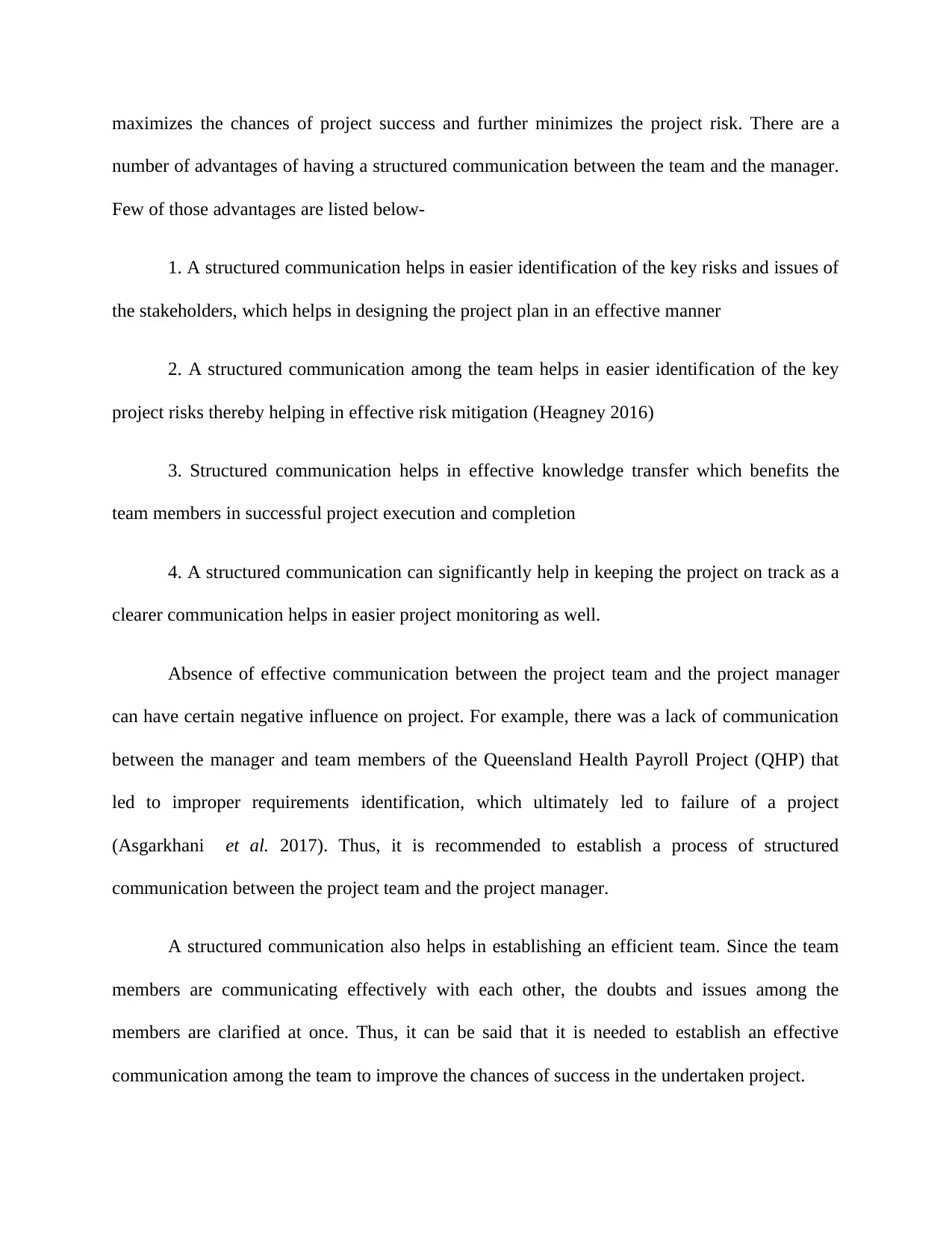
maximizes the chances of project success and further minimizes the project risk. There are a
number of advantages of having a structured communication between the team and the manager.
Few of those advantages are listed below-
1. A structured communication helps in easier identification of the key risks and issues of
the stakeholders, which helps in designing the project plan in an effective manner
2. A structured communication among the team helps in easier identification of the key
project risks thereby helping in effective risk mitigation (Heagney 2016)
3. Structured communication helps in effective knowledge transfer which benefits the
team members in successful project execution and completion
4. A structured communication can significantly help in keeping the project on track as a
clearer communication helps in easier project monitoring as well.
Absence of effective communication between the project team and the project manager
can have certain negative influence on project. For example, there was a lack of communication
between the manager and team members of the Queensland Health Payroll Project (QHP) that
led to improper requirements identification, which ultimately led to failure of a project
(Asgarkhani et al. 2017). Thus, it is recommended to establish a process of structured
communication between the project team and the project manager.
A structured communication also helps in establishing an efficient team. Since the team
members are communicating effectively with each other, the doubts and issues among the
members are clarified at once. Thus, it can be said that it is needed to establish an effective
communication among the team to improve the chances of success in the undertaken project.
number of advantages of having a structured communication between the team and the manager.
Few of those advantages are listed below-
1. A structured communication helps in easier identification of the key risks and issues of
the stakeholders, which helps in designing the project plan in an effective manner
2. A structured communication among the team helps in easier identification of the key
project risks thereby helping in effective risk mitigation (Heagney 2016)
3. Structured communication helps in effective knowledge transfer which benefits the
team members in successful project execution and completion
4. A structured communication can significantly help in keeping the project on track as a
clearer communication helps in easier project monitoring as well.
Absence of effective communication between the project team and the project manager
can have certain negative influence on project. For example, there was a lack of communication
between the manager and team members of the Queensland Health Payroll Project (QHP) that
led to improper requirements identification, which ultimately led to failure of a project
(Asgarkhani et al. 2017). Thus, it is recommended to establish a process of structured
communication between the project team and the project manager.
A structured communication also helps in establishing an efficient team. Since the team
members are communicating effectively with each other, the doubts and issues among the
members are clarified at once. Thus, it can be said that it is needed to establish an effective
communication among the team to improve the chances of success in the undertaken project.
Paraphrase This Document
Need a fresh take? Get an instant paraphrase of this document with our AI Paraphraser
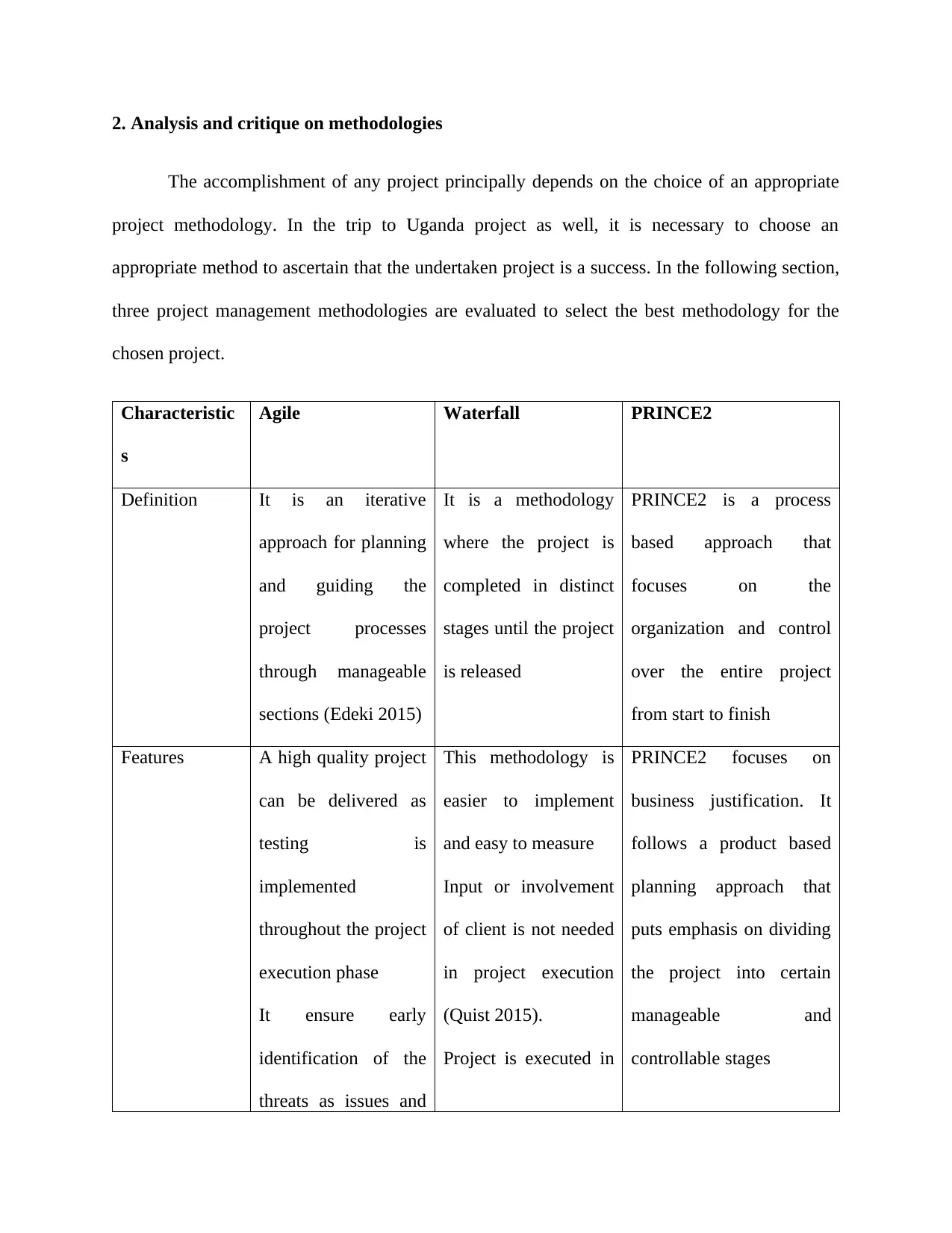
2. Analysis and critique on methodologies
The accomplishment of any project principally depends on the choice of an appropriate
project methodology. In the trip to Uganda project as well, it is necessary to choose an
appropriate method to ascertain that the undertaken project is a success. In the following section,
three project management methodologies are evaluated to select the best methodology for the
chosen project.
Characteristic
s
Agile Waterfall PRINCE2
Definition It is an iterative
approach for planning
and guiding the
project processes
through manageable
sections (Edeki 2015)
It is a methodology
where the project is
completed in distinct
stages until the project
is released
PRINCE2 is a process
based approach that
focuses on the
organization and control
over the entire project
from start to finish
Features A high quality project
can be delivered as
testing is
implemented
throughout the project
execution phase
It ensure early
identification of the
threats as issues and
This methodology is
easier to implement
and easy to measure
Input or involvement
of client is not needed
in project execution
(Quist 2015).
Project is executed in
PRINCE2 focuses on
business justification. It
follows a product based
planning approach that
puts emphasis on dividing
the project into certain
manageable and
controllable stages
The accomplishment of any project principally depends on the choice of an appropriate
project methodology. In the trip to Uganda project as well, it is necessary to choose an
appropriate method to ascertain that the undertaken project is a success. In the following section,
three project management methodologies are evaluated to select the best methodology for the
chosen project.
Characteristic
s
Agile Waterfall PRINCE2
Definition It is an iterative
approach for planning
and guiding the
project processes
through manageable
sections (Edeki 2015)
It is a methodology
where the project is
completed in distinct
stages until the project
is released
PRINCE2 is a process
based approach that
focuses on the
organization and control
over the entire project
from start to finish
Features A high quality project
can be delivered as
testing is
implemented
throughout the project
execution phase
It ensure early
identification of the
threats as issues and
This methodology is
easier to implement
and easy to measure
Input or involvement
of client is not needed
in project execution
(Quist 2015).
Project is executed in
PRINCE2 focuses on
business justification. It
follows a product based
planning approach that
puts emphasis on dividing
the project into certain
manageable and
controllable stages
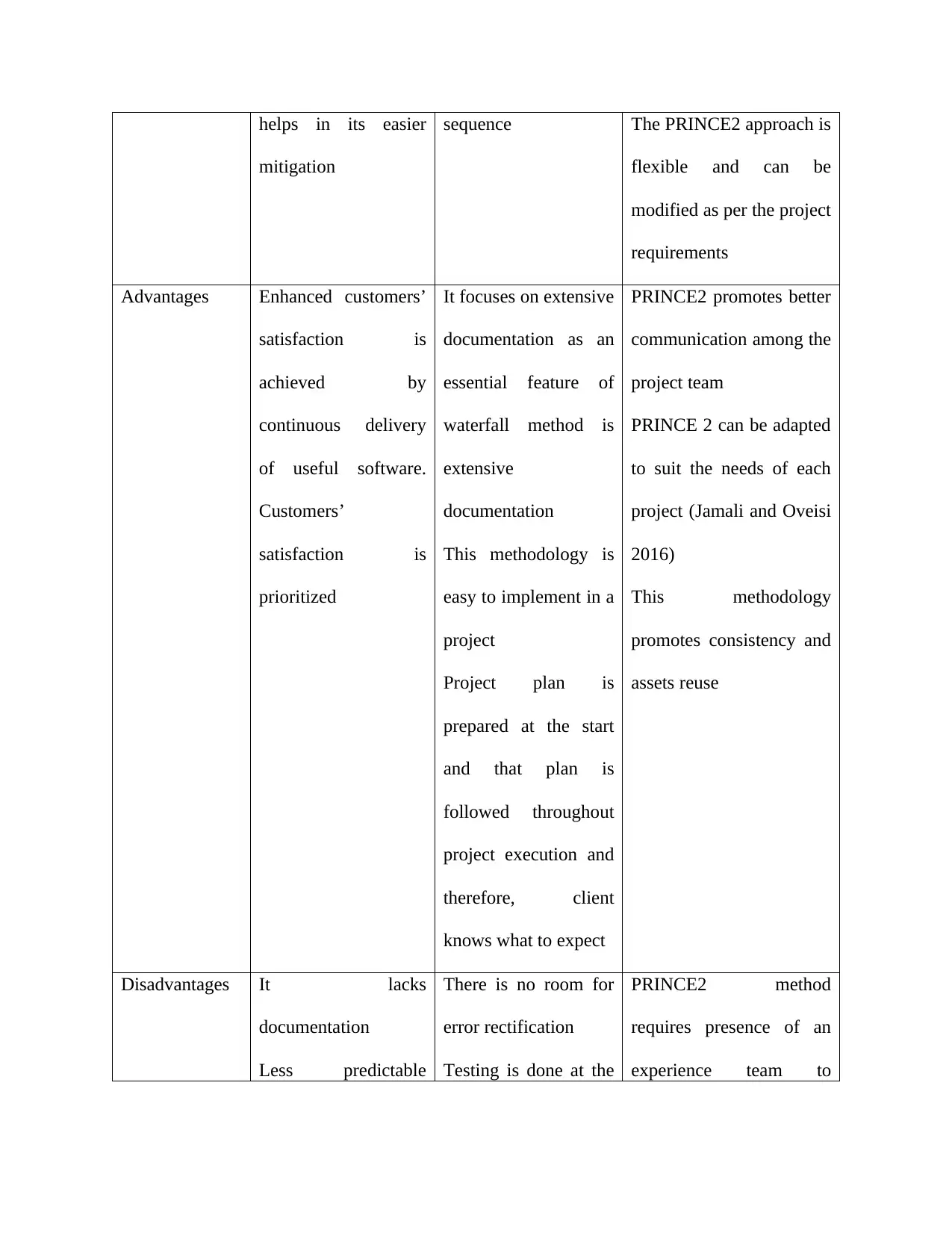
helps in its easier
mitigation
sequence The PRINCE2 approach is
flexible and can be
modified as per the project
requirements
Advantages Enhanced customers’
satisfaction is
achieved by
continuous delivery
of useful software.
Customers’
satisfaction is
prioritized
It focuses on extensive
documentation as an
essential feature of
waterfall method is
extensive
documentation
This methodology is
easy to implement in a
project
Project plan is
prepared at the start
and that plan is
followed throughout
project execution and
therefore, client
knows what to expect
PRINCE2 promotes better
communication among the
project team
PRINCE 2 can be adapted
to suit the needs of each
project (Jamali and Oveisi
2016)
This methodology
promotes consistency and
assets reuse
Disadvantages It lacks
documentation
Less predictable
There is no room for
error rectification
Testing is done at the
PRINCE2 method
requires presence of an
experience team to
mitigation
sequence The PRINCE2 approach is
flexible and can be
modified as per the project
requirements
Advantages Enhanced customers’
satisfaction is
achieved by
continuous delivery
of useful software.
Customers’
satisfaction is
prioritized
It focuses on extensive
documentation as an
essential feature of
waterfall method is
extensive
documentation
This methodology is
easy to implement in a
project
Project plan is
prepared at the start
and that plan is
followed throughout
project execution and
therefore, client
knows what to expect
PRINCE2 promotes better
communication among the
project team
PRINCE 2 can be adapted
to suit the needs of each
project (Jamali and Oveisi
2016)
This methodology
promotes consistency and
assets reuse
Disadvantages It lacks
documentation
Less predictable
There is no room for
error rectification
Testing is done at the
PRINCE2 method
requires presence of an
experience team to
⊘ This is a preview!⊘
Do you want full access?
Subscribe today to unlock all pages.

Trusted by 1+ million students worldwide
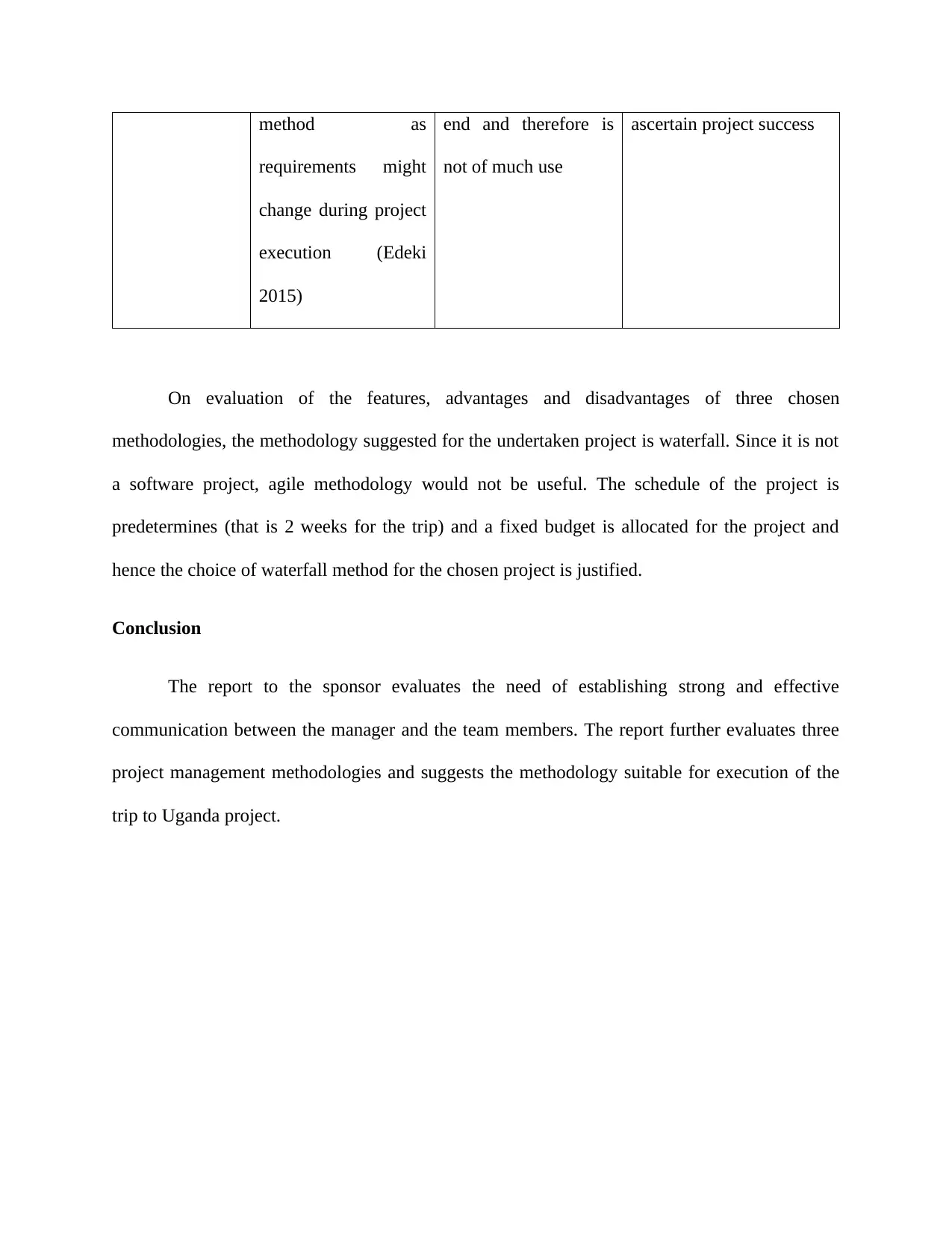
method as
requirements might
change during project
execution (Edeki
2015)
end and therefore is
not of much use
ascertain project success
On evaluation of the features, advantages and disadvantages of three chosen
methodologies, the methodology suggested for the undertaken project is waterfall. Since it is not
a software project, agile methodology would not be useful. The schedule of the project is
predetermines (that is 2 weeks for the trip) and a fixed budget is allocated for the project and
hence the choice of waterfall method for the chosen project is justified.
Conclusion
The report to the sponsor evaluates the need of establishing strong and effective
communication between the manager and the team members. The report further evaluates three
project management methodologies and suggests the methodology suitable for execution of the
trip to Uganda project.
requirements might
change during project
execution (Edeki
2015)
end and therefore is
not of much use
ascertain project success
On evaluation of the features, advantages and disadvantages of three chosen
methodologies, the methodology suggested for the undertaken project is waterfall. Since it is not
a software project, agile methodology would not be useful. The schedule of the project is
predetermines (that is 2 weeks for the trip) and a fixed budget is allocated for the project and
hence the choice of waterfall method for the chosen project is justified.
Conclusion
The report to the sponsor evaluates the need of establishing strong and effective
communication between the manager and the team members. The report further evaluates three
project management methodologies and suggests the methodology suitable for execution of the
trip to Uganda project.
Paraphrase This Document
Need a fresh take? Get an instant paraphrase of this document with our AI Paraphraser
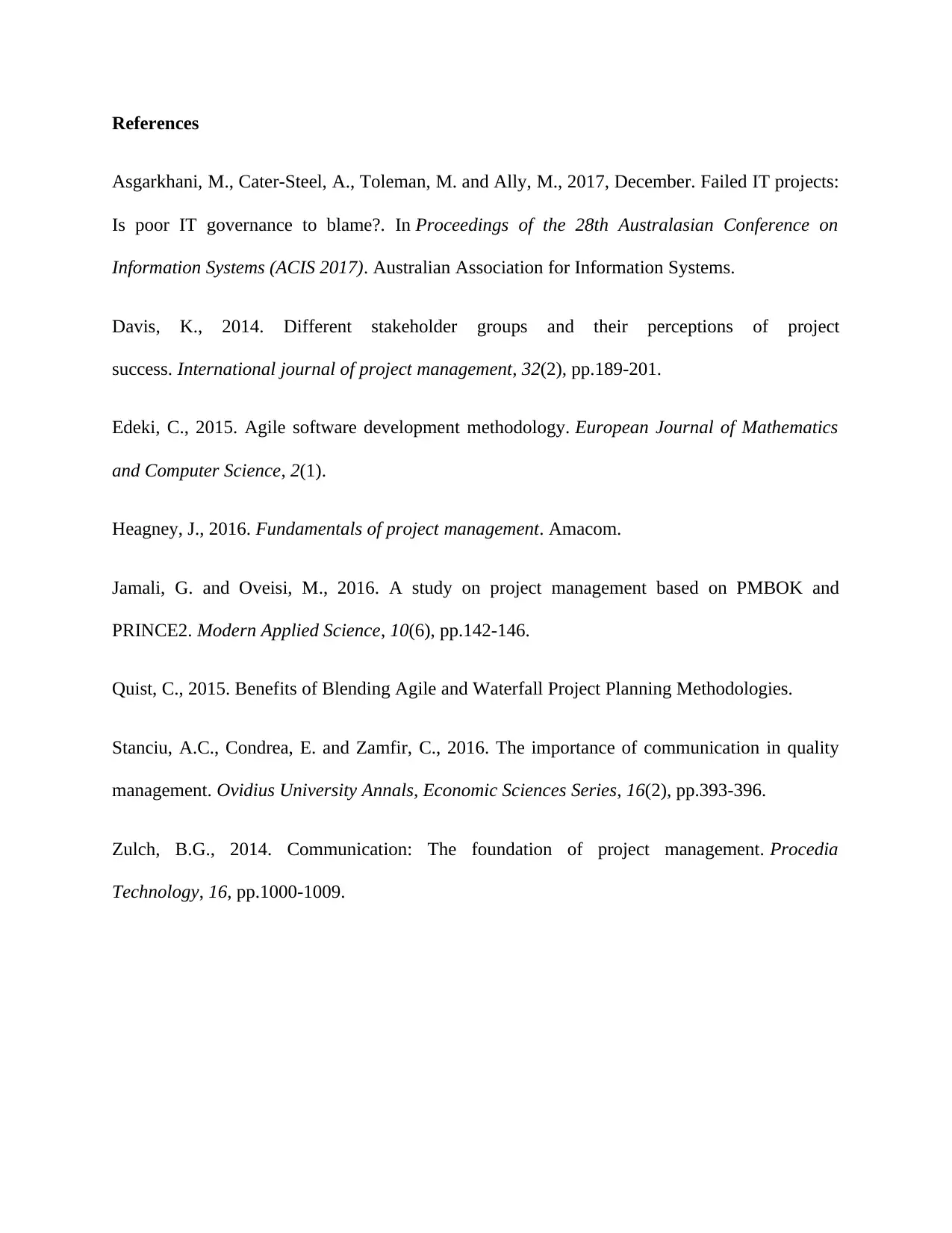
References
Asgarkhani, M., Cater-Steel, A., Toleman, M. and Ally, M., 2017, December. Failed IT projects:
Is poor IT governance to blame?. In Proceedings of the 28th Australasian Conference on
Information Systems (ACIS 2017). Australian Association for Information Systems.
Davis, K., 2014. Different stakeholder groups and their perceptions of project
success. International journal of project management, 32(2), pp.189-201.
Edeki, C., 2015. Agile software development methodology. European Journal of Mathematics
and Computer Science, 2(1).
Heagney, J., 2016. Fundamentals of project management. Amacom.
Jamali, G. and Oveisi, M., 2016. A study on project management based on PMBOK and
PRINCE2. Modern Applied Science, 10(6), pp.142-146.
Quist, C., 2015. Benefits of Blending Agile and Waterfall Project Planning Methodologies.
Stanciu, A.C., Condrea, E. and Zamfir, C., 2016. The importance of communication in quality
management. Ovidius University Annals, Economic Sciences Series, 16(2), pp.393-396.
Zulch, B.G., 2014. Communication: The foundation of project management. Procedia
Technology, 16, pp.1000-1009.
Asgarkhani, M., Cater-Steel, A., Toleman, M. and Ally, M., 2017, December. Failed IT projects:
Is poor IT governance to blame?. In Proceedings of the 28th Australasian Conference on
Information Systems (ACIS 2017). Australian Association for Information Systems.
Davis, K., 2014. Different stakeholder groups and their perceptions of project
success. International journal of project management, 32(2), pp.189-201.
Edeki, C., 2015. Agile software development methodology. European Journal of Mathematics
and Computer Science, 2(1).
Heagney, J., 2016. Fundamentals of project management. Amacom.
Jamali, G. and Oveisi, M., 2016. A study on project management based on PMBOK and
PRINCE2. Modern Applied Science, 10(6), pp.142-146.
Quist, C., 2015. Benefits of Blending Agile and Waterfall Project Planning Methodologies.
Stanciu, A.C., Condrea, E. and Zamfir, C., 2016. The importance of communication in quality
management. Ovidius University Annals, Economic Sciences Series, 16(2), pp.393-396.
Zulch, B.G., 2014. Communication: The foundation of project management. Procedia
Technology, 16, pp.1000-1009.
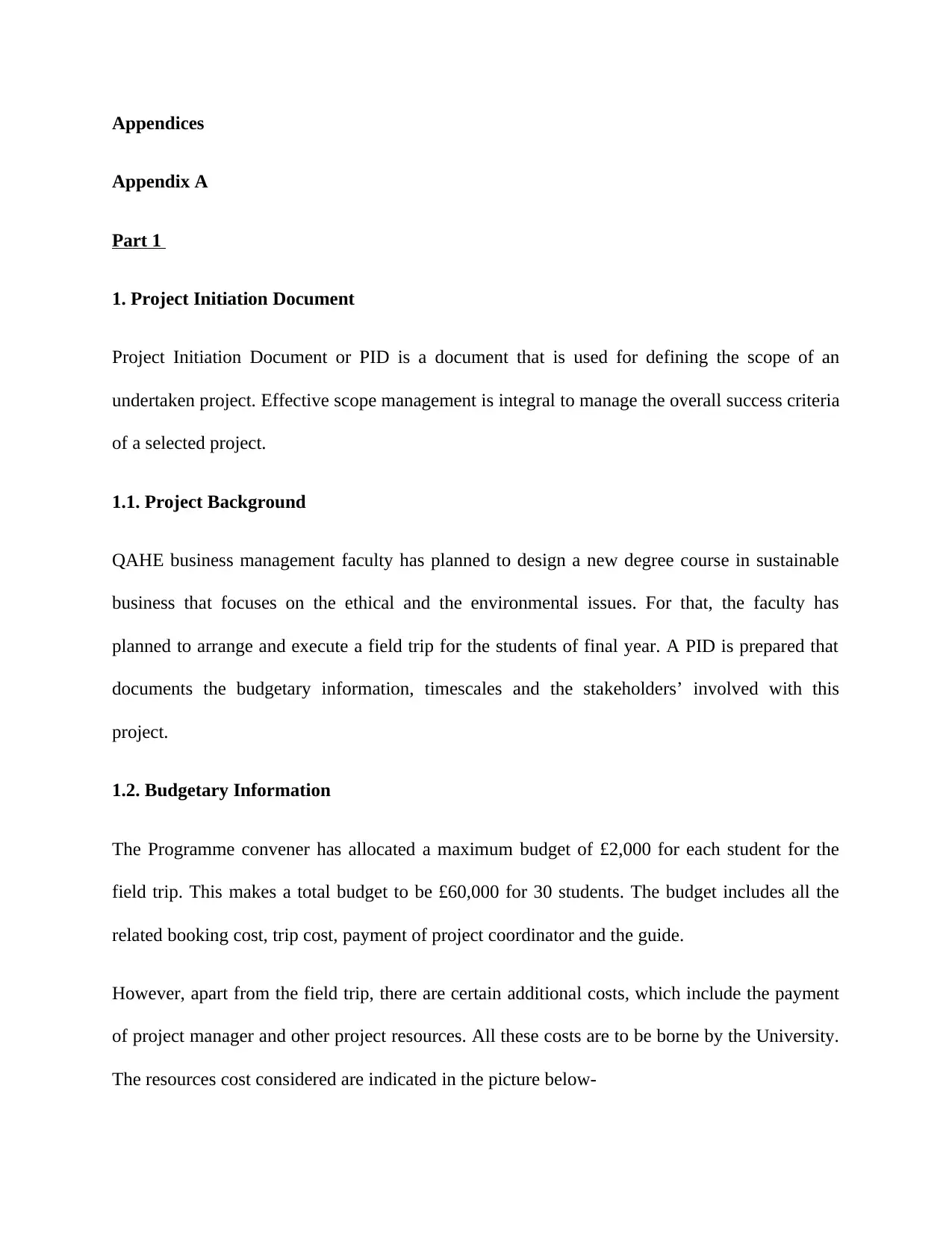
Appendices
Appendix A
Part 1
1. Project Initiation Document
Project Initiation Document or PID is a document that is used for defining the scope of an
undertaken project. Effective scope management is integral to manage the overall success criteria
of a selected project.
1.1. Project Background
QAHE business management faculty has planned to design a new degree course in sustainable
business that focuses on the ethical and the environmental issues. For that, the faculty has
planned to arrange and execute a field trip for the students of final year. A PID is prepared that
documents the budgetary information, timescales and the stakeholders’ involved with this
project.
1.2. Budgetary Information
The Programme convener has allocated a maximum budget of £2,000 for each student for the
field trip. This makes a total budget to be £60,000 for 30 students. The budget includes all the
related booking cost, trip cost, payment of project coordinator and the guide.
However, apart from the field trip, there are certain additional costs, which include the payment
of project manager and other project resources. All these costs are to be borne by the University.
The resources cost considered are indicated in the picture below-
Appendix A
Part 1
1. Project Initiation Document
Project Initiation Document or PID is a document that is used for defining the scope of an
undertaken project. Effective scope management is integral to manage the overall success criteria
of a selected project.
1.1. Project Background
QAHE business management faculty has planned to design a new degree course in sustainable
business that focuses on the ethical and the environmental issues. For that, the faculty has
planned to arrange and execute a field trip for the students of final year. A PID is prepared that
documents the budgetary information, timescales and the stakeholders’ involved with this
project.
1.2. Budgetary Information
The Programme convener has allocated a maximum budget of £2,000 for each student for the
field trip. This makes a total budget to be £60,000 for 30 students. The budget includes all the
related booking cost, trip cost, payment of project coordinator and the guide.
However, apart from the field trip, there are certain additional costs, which include the payment
of project manager and other project resources. All these costs are to be borne by the University.
The resources cost considered are indicated in the picture below-
⊘ This is a preview!⊘
Do you want full access?
Subscribe today to unlock all pages.

Trusted by 1+ million students worldwide
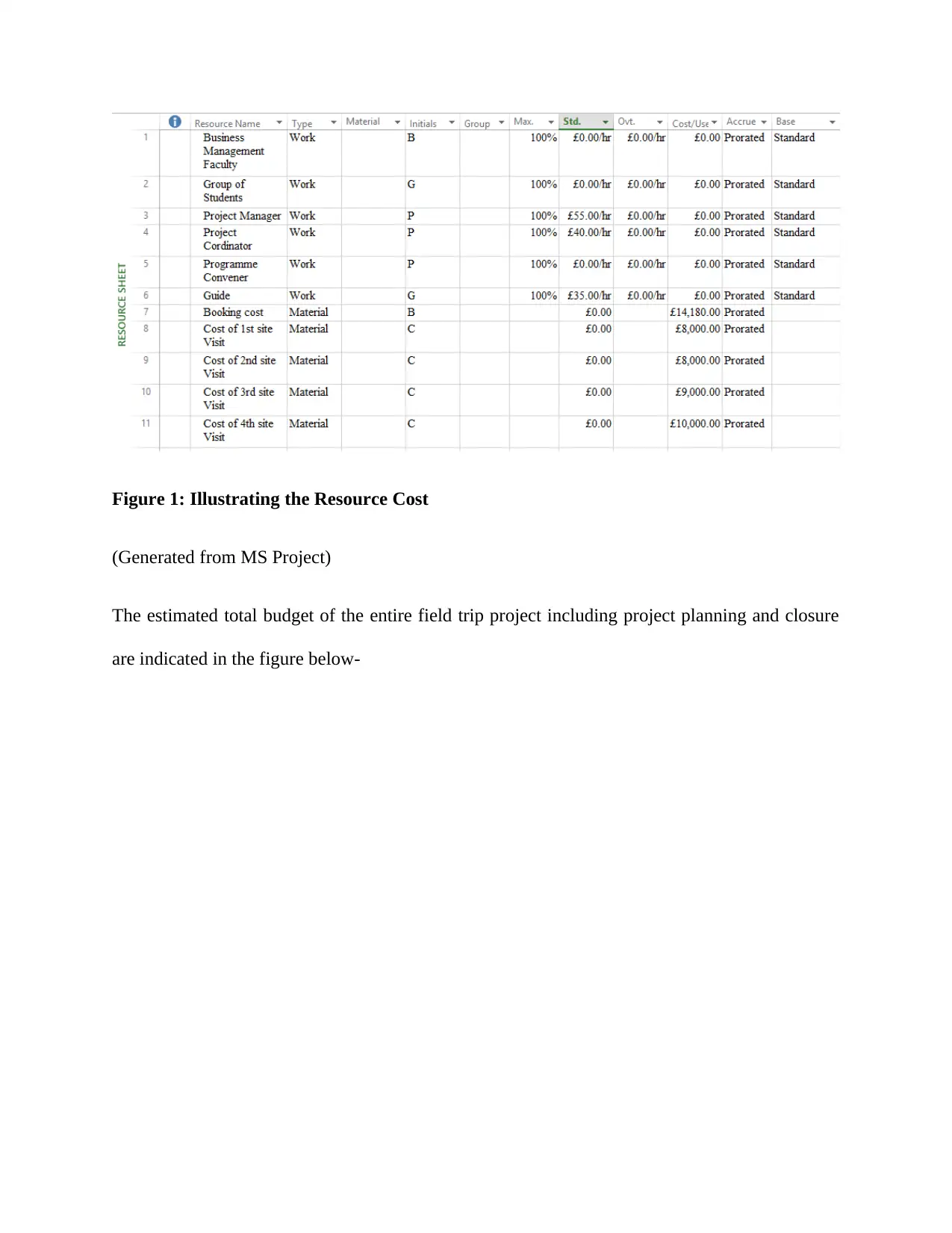
Figure 1: Illustrating the Resource Cost
(Generated from MS Project)
The estimated total budget of the entire field trip project including project planning and closure
are indicated in the figure below-
(Generated from MS Project)
The estimated total budget of the entire field trip project including project planning and closure
are indicated in the figure below-
Paraphrase This Document
Need a fresh take? Get an instant paraphrase of this document with our AI Paraphraser
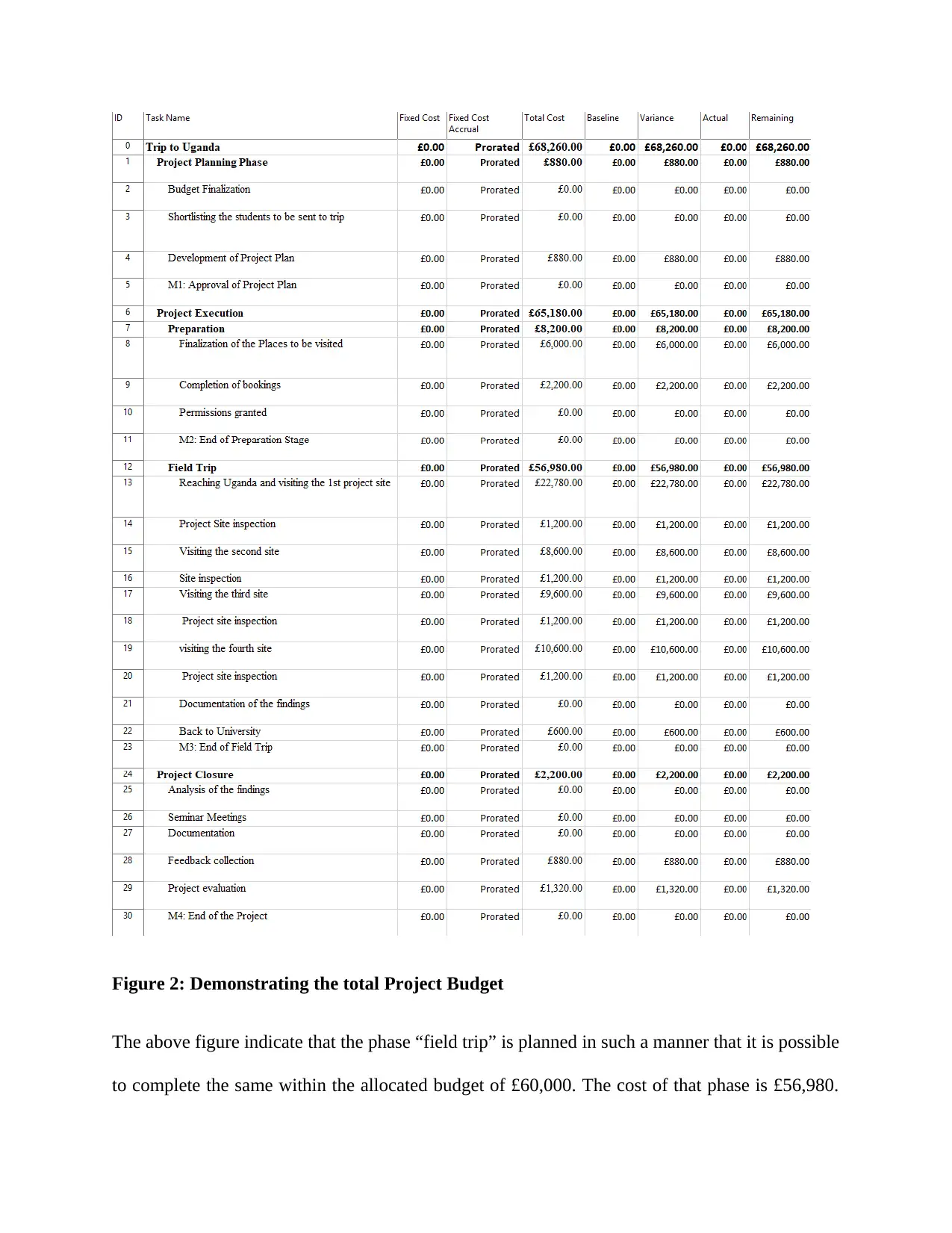
Figure 2: Demonstrating the total Project Budget
The above figure indicate that the phase “field trip” is planned in such a manner that it is possible
to complete the same within the allocated budget of £60,000. The cost of that phase is £56,980.
The above figure indicate that the phase “field trip” is planned in such a manner that it is possible
to complete the same within the allocated budget of £60,000. The cost of that phase is £56,980.
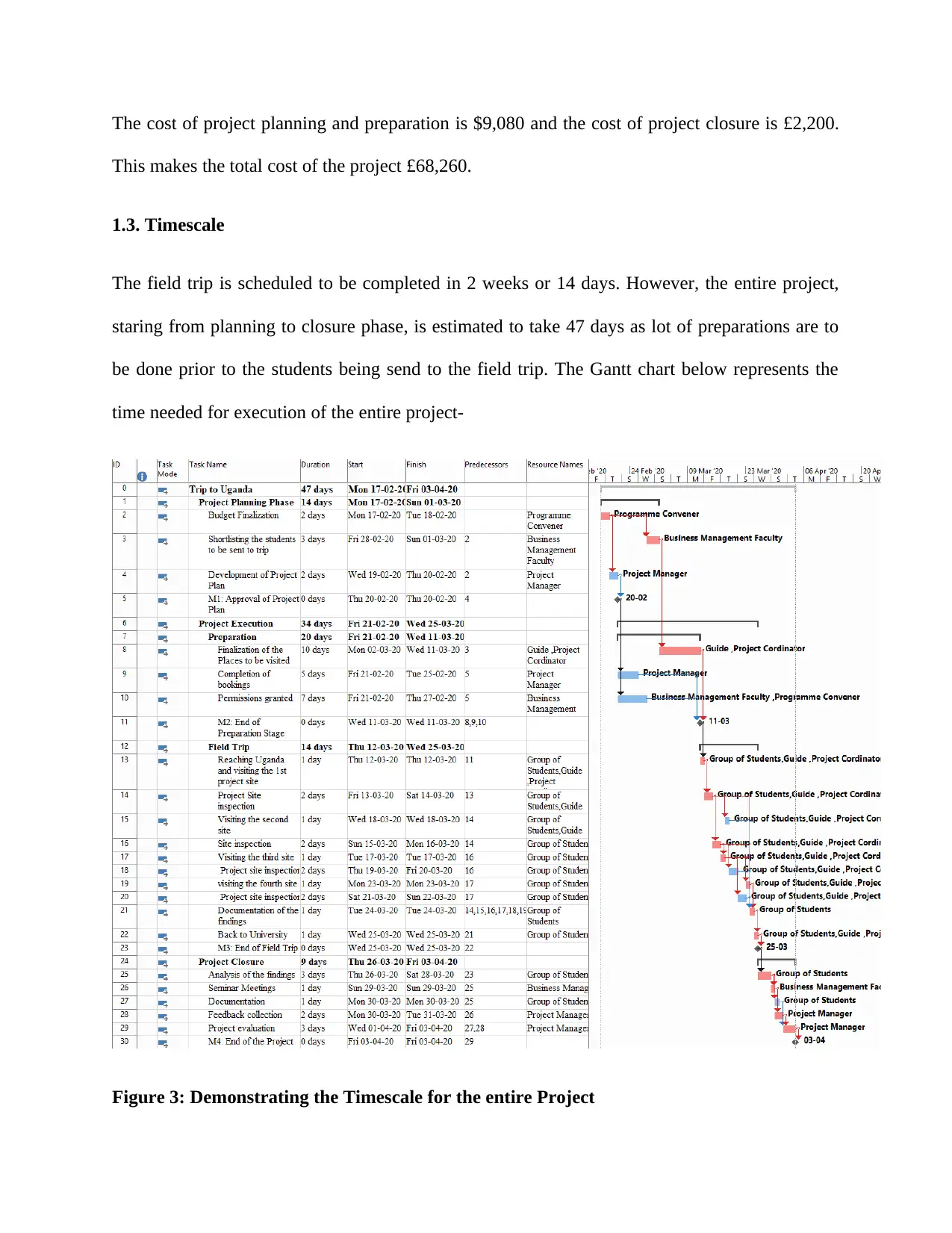
The cost of project planning and preparation is $9,080 and the cost of project closure is £2,200.
This makes the total cost of the project £68,260.
1.3. Timescale
The field trip is scheduled to be completed in 2 weeks or 14 days. However, the entire project,
staring from planning to closure phase, is estimated to take 47 days as lot of preparations are to
be done prior to the students being send to the field trip. The Gantt chart below represents the
time needed for execution of the entire project-
Figure 3: Demonstrating the Timescale for the entire Project
This makes the total cost of the project £68,260.
1.3. Timescale
The field trip is scheduled to be completed in 2 weeks or 14 days. However, the entire project,
staring from planning to closure phase, is estimated to take 47 days as lot of preparations are to
be done prior to the students being send to the field trip. The Gantt chart below represents the
time needed for execution of the entire project-
Figure 3: Demonstrating the Timescale for the entire Project
⊘ This is a preview!⊘
Do you want full access?
Subscribe today to unlock all pages.

Trusted by 1+ million students worldwide
1 out of 26
Related Documents
Your All-in-One AI-Powered Toolkit for Academic Success.
+13062052269
info@desklib.com
Available 24*7 on WhatsApp / Email
![[object Object]](/_next/static/media/star-bottom.7253800d.svg)
Unlock your academic potential
Copyright © 2020–2025 A2Z Services. All Rights Reserved. Developed and managed by ZUCOL.




